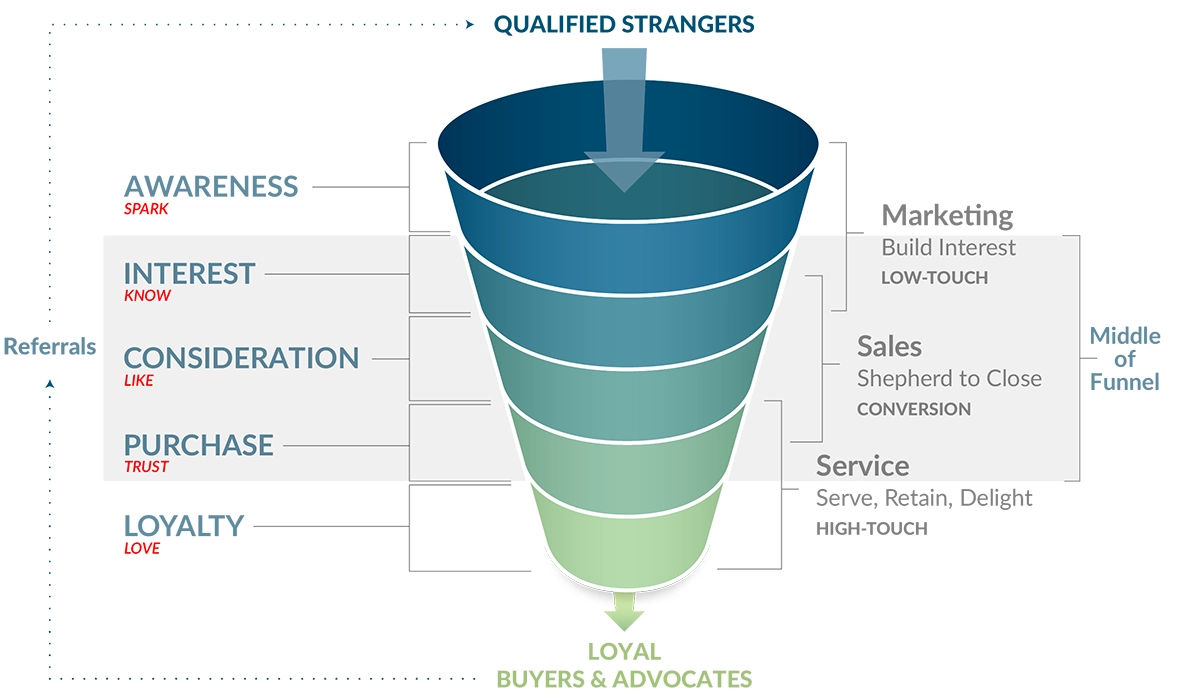The Middle of Your Marketing Funnel:
Conversion Gold Mine or Bottomless Pit?
Three questions to help assess your risk.
Three actions to help you find the treasure you’re working to uncover.
Whether you know it as the “Customer Journey” or a “Marketing Funnel,” there can be a ton more opportunity – and potential loss – in the middle. The leads are warmer and, for experienced sales professionals, this is exciting territory to navigate. But this same territory can be filled with hidden danger — especially for those navigating a digital marketing transition.
Nearly every article I read about Customer Journeys takes too broad a perspective. Yes, people and teams need to understand the anatomy of the journey and how the role of each member will keep buyers moving into and through the marketing funnel. And yet,, while top-of-funnel activity is mostly about making the numbers work and bottom-of-funnel all about disciplined service delivery, the middle of the Marketing Funnel is filled with tricky transitions and handoffs.
The fact is, most of the established firms I meet have already developed their Top-of-Funnel populations. Buyers in the marketplace know the brand. They often respect the product or service. They just haven’t found a compelling reason to take the next step. The real challenge for these established companies is to move enough of the swirling leads in the middle, closer to conversion at the bottom.
It’s time — actually way past time — to focus on the opportunities and risks that businesses face in the middle. But first, let’s get straight on terminology. (Experts, please bear with me. I know this is basic stuff, but there are misperceptions that can create chronic problems.)
Marketing Funnel: A fairly common marketing-oriented term for the journey that a customer takes from first discovering your product or service to becoming a loyal buyer. The process begins when we attract a large number of qualified strangers to our brand offering. Then we nurture many of those leads who show interest in our brand. Finally, we convert as many of the best prospects as possible by helping them become buyers… and ultimately loyal advocates who will refer more qualified leads to the top of our funnel.
The numbers diminish as they move through the pipeline… like a funnel, right?
Now think about the three, very unique groups of people and skill sets who ensure that buyers progress through our funnel…
Marketing Professional – A curious and analytical individual who can discern what qualified strangers want, express how your offering uniquely fills that need, and can show your best leads how easy it is to take smart action. Do they know what to do when someone is ready to buy? Probably not. But they’re awfully good at that other stuff.
Sales Professional – A naturally warm confidence-builder who genuinely enjoys helping cautious leads turn into confident buyers. And not to oversell the sales role, but these folks are severely optimistic and have very thick skin. Rejection doesn’t deter them because they believe in their product and they know they can make the long-term numbers work for the business. And they can.
But one word of warning… If you have a sales professional who thinks they practice a nicer form of selling, called “marketing,” then they don’t have the perseverance required to be in sales. They may be more helpful on the marketing team.
Service Professional – Once a transaction is closed, Service Professionals hop into action to ensure that customers have the best possible experience with your brand. Service Professionals are the golden retriever of the marketing funnel. They live to ensure that customers get what they expect and deserve. They experience an incredible endorphin rush when a customer smiles, or says, “Thank you.” And even in that moment of drop-the-mic success, they’ll say something like, “Now you let me know if there’s anything else we can do for you.”
So why is the middle so risky?
Take a look at the marketing funnel model shown here.

At the top are the thousands of qualified strangers you work hard to attract. At the bottom is that unique set of buyers who find your people and brand truly delightful. On the left is the Customer Journey (your funnel from the buyer’s perspective) showing five stages of affinity… and in red, the five levels of emotional attachment that align with that journey.
The Middle of Funnel, in gray, is that critical zone where your most valuable strangers become visible and transition (with your team’s help) from leads to prospects and then to buyers.
I think you can see it, on the right side of the diagram. That middle zone — which holds your highest potential for marketplace success this year — is filled with transitions between players who have very different mind sets. This process will go very badly unless teams are well aligned.
Three Risk Assessment Questions
In evaluating your marketing and sales conversion process, ask yourself:
- Do my teams understand and express our brand promise with continuity?
- Are the handoffs reliable, offering a seamless experience for prospects?
- Does everyone understand the actions that will move prospects from knowing, to liking, to trusting and, ultimately, to loving our brand?
Let’s be clear, the Middle-of-Funnel transition zone is a place where unqualified prospects should go away. But when a high-value prospect drops out from the middle, you’ve lost a future loyal customer… one you’ve probably spent a lot of time and resources moving to the middle.
Three Actions to Build Alignment
So, how can we ensure that our teams are best prepared to minimize the risk of loss and maximize our opportunity to win new customers in the middle?
- Clarify Roles – Envision a transition process that everyone understands and works together to execute. Include methods for documentation and performance measurement (both quantitative and qualitative).
- Get Your Messaging Straight – Ensure that everyone sings from the same songbook, by building a message platform, a core brand value statement, and a brand manifesto.
- Think Like a Prospect – Align your brand messaging and actions with those vital emotional aspects of the Customer Journey:
- A Brand Identity that will spark interest in 1 to 3 seconds
- A Tag or Slogan that helps prospects know what you stand for
- A Message Platform that drives prospects to like your insightful solutions
- A Brand Promise or Manifesto that helps prospects trust your team
- An after-purchase survey or rating system that reminds customers how much they love your brand and want to refer it to others
Is your team ready to deliver better conversion performance — performance that is truly worthy of your brand? Maybe it’s time for some alignment in the middle.




0 Comments